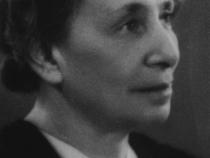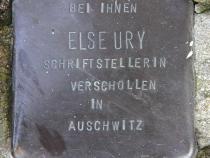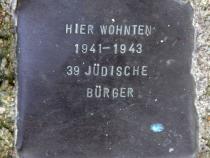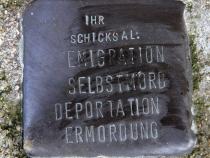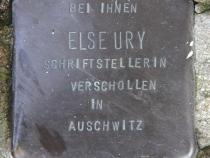Location
Solinger Straße 10
District
Moabit
Stone was laid
September 2003
Born
01 November 1877 in Berlin
Deportation
on 12 January 1943
to
Auschwitz
Murdered
13 January 1943 in Auschwitz
Else Ury was one of the best known German children’s authors of the 1920s. She was born on 1 November 1877 in Heiliggeist Strasse, near Alexanderplatz in Berlin-Mitte, to third-generation Berliners. Her father, Emil Ury, was a tobacco manufacturer and her mother Franziska, née Schlesinger, was in charge of the household. Her brother Ludwig (1870- 1963) became a lawyer and Hans (1873-1937), a doctor. Her sister Käthe (1881-1943) – the baby of the family (or “Nesthäkchen” in German) – trained to be a gymnastics teacher before marrying the head of the Berlin planning department and building control office, Hugo Heymann. Else Ury attended the “Luisenschule”, a grammar school for girls. But instead of following the traditional path and marrying after leaving school, Else started writing. Her first book, “Was das Sonntagskind erlauscht” (‘What the Lucky Child Heard’), a kind of modern fairytale, was published by Globus in 1905. In the same year, the Ury family moved to Savignyplatz, Berlin. Around 1913 the first two parts of Else Ury’s acclaimed “Nesthäkchen” series were published. During World War I, she wrote patriotically tinged novels which were serialized in the magazine “Das Kränzchen”. In some of her later novels she expressed support for the tenets of the German women’s movement. By 1925, she had written the tenth and last part of the “Nesthäkchen” series, which was among the best-loved children’s books of the day. The stories were broadcast on the radio and read by millions. Though now an acclaimed author, Else Ury continued to live with her parents and did not have any contact with the literary avant-garde in Berlin. However, she bought herself a holiday home in Krummhübel in Silesia (now Karpacz), which became known as ‘Nesthäkchen House’. She wrote another series under the title “Professors Zwillingen”. She published her last book, “Jugend voraus”, in 1933.
When the Nazis came to power, Else Ury was also hit by their insidious persecutory measures. The members of the Ury family were stripped of their rights and their lives threatened. Else’s brother Hans chose to take his own life in 1937. Else’s remaining brother and sister went to live with their children abroad: Ludwig Ury to London; Käthe Heimann and her husband Hugo to Amsterdam. Else Ury was forced to move into compulsory accommodation for Jews in Solinger Strasse. Here, she cared for her over 90 year-old mother, who died in 1940. On 6 January 1943, Else Ury was taken by the Gestapo to the assembly camp at Grosse Hamburger Strasse 26. On 12 January she was deported to Auschwitz in a cattle truck on the ‘26th transport to the east’, together with 1100 Berlin Jews. She died in a gas chamber on 13 January 1943. Her sister Käthe and her husband Hugo and their daughter, son-in-law and one grandchild were deported from Amsterdam and murdered. Later, Else Ury’s nephew in London was able to accept her inheritance and ensure that her books were published again. Generations of young readers have identified with the characters in Else Ury’s 38 books, which survived the war and the postwar period and continue to fascinate readers today. Her work was accessible to all children, regardless of faith, and has become part of German literary culture, especially the “Nesthäkchen” series.
When the Nazis came to power, Else Ury was also hit by their insidious persecutory measures. The members of the Ury family were stripped of their rights and their lives threatened. Else’s brother Hans chose to take his own life in 1937. Else’s remaining brother and sister went to live with their children abroad: Ludwig Ury to London; Käthe Heimann and her husband Hugo to Amsterdam. Else Ury was forced to move into compulsory accommodation for Jews in Solinger Strasse. Here, she cared for her over 90 year-old mother, who died in 1940. On 6 January 1943, Else Ury was taken by the Gestapo to the assembly camp at Grosse Hamburger Strasse 26. On 12 January she was deported to Auschwitz in a cattle truck on the ‘26th transport to the east’, together with 1100 Berlin Jews. She died in a gas chamber on 13 January 1943. Her sister Käthe and her husband Hugo and their daughter, son-in-law and one grandchild were deported from Amsterdam and murdered. Later, Else Ury’s nephew in London was able to accept her inheritance and ensure that her books were published again. Generations of young readers have identified with the characters in Else Ury’s 38 books, which survived the war and the postwar period and continue to fascinate readers today. Her work was accessible to all children, regardless of faith, and has become part of German literary culture, especially the “Nesthäkchen” series.






